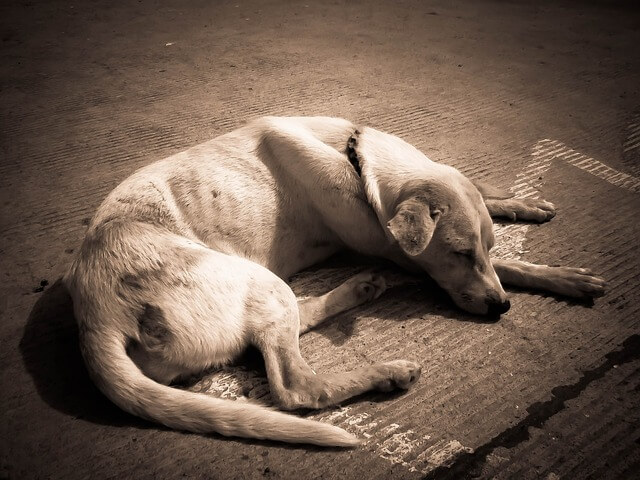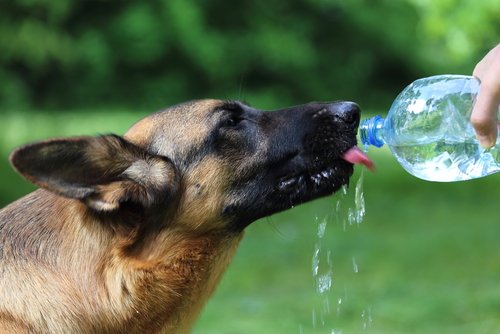Tips to Fatten Up Your Dog
According to the characteristics of the dog's breed, its healthy weight will vary. If you don't know this information, then we suggest you consult with your veterinarian.

When a dog isn’t in its healthy weight range, owners must help it to recover progressively. And what does this involve? We’ll bring you tips to fatten up your dog until they reach the right body mass index and fat.
Some dogs naturally have a thin build and a slim appearance. But if your dog has always had a normal weight and has suddenly lost weight drastically, you’ll need to find the cause and supply a prompt solution.
Possible causes of weight loss
The causes of weight loss in pets can be many and varied. Among the most common are a diet that’s poor in nutrients, the presence of parasites, stress in the animal regarding a particular situation, among other things. Below we’ll discuss each of these in more detail.

1. Intestinal parasites
When a dog suffers from intestinal parasites, it tends to lose weight drastically in a short period of time. Their extreme thinness is caused by the parasites stealing nutrients every time the dog eats a meal.
However, parasites can also cause bloating, so extreme thinness can often be hidden by this. It’s very important to check your pet closely to see if their ribs are noticeable. If so, then an immediate visit to the vet will be necessary.
2. Nervousness or stress
Although this is one of the most difficult causes to notice, it’s usually one of the most common. Changes in the environment or in the pet’s habits can have a negative impact on them, to the point that they stop eating due to nervousness, stress, or depression. This is usually most evident when a separation has occurred and the pet is grieving.
3. A poor or inappropriate diet
A diet that is poor in nutrients or doesn’t contain the nutrients your dog needs most is a common cause of weight loss. If this happens, it’s essential to talk to your vet about changing their diet, or supplementing it.
How to fatten up your dog correctly
When wanting to fatten up your dog you shouldn’t rush it. You won’t need to increase the amount of food from one day to the next in an exaggerated way. In fact, what you should do is to opt for the following:
1. Use good quality food
Sometimes it isn’t the quantity of food that’s important, but the quality. However, this doesn’t mean that you should resort to the most expensive. What it does mean is that you should be concerned about looking for options that can offer the dog complete nutrition and a balanced diet.
Food that contains between 12 and 23% protein per serving will be a good choice for dogs. Proteins can also be obtained from meats and fats but you shouldn’t give them excessive amounts.
There’s also special food to help fatten sick dogs which is reinforced with the vitamins and minerals their bodies need. Once this food is finished, try to find a feed rich in nutrients so as not to impoverish the diet again.
2. Give more appetizing food
If you can’t get your dog to eat their food, you can mix it with their favorite food, such as some chicken, beef, veal or even a little beef broth. You can also introduce a few pieces of dog snacks and other treats to try and get the animal to eat.

3. Vegetable enzyme
Vegetable enzyme is usually prescribed by veterinarians in certain cases. It usually comes in pill, capsule or paste form. Its function is to help restore and maintain the health of the dog’s digestive system, in addition to increasing the number of nutrients the dog can absorb each time it eats a meal.
4. Frequency of meals
It is also important to keep in mind the order and adherence to meal times. The more the schedules are respected, the less time the dog will get fat and recover. On the other hand, it should be taken into account that, depending on the age of the pet and its condition, the number of meals will vary.

5. Water is very important
A good diet must be complemented by the correct intake of water. Without the necessary amount of water, the dog’s body won’t be able to function properly and nutrient absorption will not take place. It’s essential to keep enough fresh water for the dog so that they can drink it whenever they need to.
6. Physical exercise
As long as the vet authorizes it, you should complement the dog’s diet and hydration with an appropriate exercise routine. The purpose of this is to strengthen their body and, of course, to whet their appetite so that they can gain weight until he reaches their ideal weight.
7. Eliminate sources of stress
If the weight loss is caused by an emotional or stress factor, increasing the quality or quantity of food to restore your dog’s appetite won’t always be enough. In these cases, you’ll need to try and identify and eliminate whatever is causing the discomfort. This can be anything from a simple change in their routine or diet, to depression due to a lack of attention from their owner.
To fix this you just need to spend more time with them to get them. As they start feeling better, your dog should regain his appetite. Remember that if this doesn’t happen and only worsens their condition, you should go to see an expert immediately.
Heed the veterinarian’s instructions and, in a short time, your pet’s health will recover. Remember that it’s better to invest in time and patience than to expect an overnight improvement.

